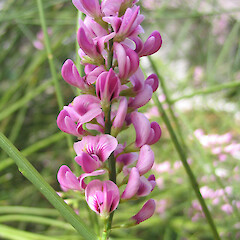Carmichaelia glabrescens
Common name
pink broom
Synonyms
Notospartium glabrescens Petrie
Family
Fabaceae
Flora category
Vascular – Native
Endemic taxon
Yes
Endemic genus
No
Endemic family
No
Structural class
Trees & Shrubs - Dicotyledons
NVS code
The National Vegetation Survey (NVS) Databank is a physical archive and electronic databank containing records of over 94,000 vegetation survey plots - including data from over 19,000 permanent plots. NVS maintains a standard set of species code abbreviations that correspond to standard scientific plant names from the Ngä Tipu o Aotearoa - New Zealand Plants database.
CARGLA
Current conservation status
The conservation status of all known New Zealand vascular plant taxa at the rank of species and below were reassessed in 2017 using the New Zealand Threat Classification System (NZTCS) – more information about this can be found on the NZTCS website. This report includes a statistical summary and brief notes on changes since 2012 and replaces all previous NZTCS lists for vascular plants.
Please note, threat classifications are often suggested by authors when publications fall between NZTCS assessment periods – an interim threat classification status has not been assessed by the NZTCS panel.
- Conservation status of New Zealand indigenous vascular plants, 2017 . 2018. Peter J. de Lange, Jeremy R. Rolfe, John W. Barkla, Shannel P. Courtney, Paul D. Champion, Leon R. Perrie, Sarah M. Beadel, Kerry A. Ford, Ilse Breitwieser, Ines Schönberger, Rowan Hindmarsh-Walls, Peter B. Heenan and Kate Ladley. Department of Conservation. Source: NZTCS and licensed by DOC for reuse under the Creative Commons Attribution 4.0 International licence.
2017 | Not Threatened
Previous conservation statuses
2012 | Not Threatened
2009 | Not Threatened
2004 | Not Threatened
Brief description
Shrub with many untidy erect flattened leafless greenish twigs. Twigs 2-4mm wide, smooth. Flowers pink, pea-like, in short spikes. Fruit a flattened papery dry pod containing 2-3 hard mottled seeds and which does not split open.
Distribution
Endemic. New Zealand: South Island (Marlborough) - south of the Awatere Fault
Habitat
Lowland to montane. A species of alluvial terraces, gorges, cliff faces and steep valley sides.
Detailed description
Leafless, spreading to upright, shrub or small tree up to 7 m tall. Branchlets slender, 120–400 × 1.8–4.0 mm, drooping, green, compressed. Leaves on branchlets reduced to a triangular scale, glabrous, < 0.8 mm long. Inflorescence a raceme, up to 30 mm long, with up to 20 flowers; pedicel 1.0–3.5 mm long, sparsely hairy. Calyx 1.5–2.4 × 1.5–2.4 mm, outer surface sparsely hairy to glabrescent, or glabrous, green; lobes 0.4–0.6 mm long, triangular. Flowers pink with dark pink veins, up to 8 mm long. Standard 7.0–7.5 × 6.3–6.6 mm, obovate, recurved; wings 5.3–7.8 × 1.0–1.7 mm, oblong, shorter than keel; keel 6.6–8.5 × 2.1–3.2 mm. Stamens 6.0–7.5 mm long. Pistil 7.8–8.4 mm long, exserted beyond stamens, ovary glabrous. Pods 8.0–28.0 × 2.8–5.2 mm, linear, laterally compressed, strongly constricted between the seeds, the seed outline not visible through the dry fruit wall, and the lower filaments are usually absent on mature fruits, indehiscent; beak up to 2.5 mm long, narrowly triangular, tapering to the persistent style; with up to 10 seeds. Seeds 2.0–3.5 mm long, reniform to reniform-triangular, light green-yellow, buff or orange-brown, often with black mottling.
Similar taxa
Carmichaelia carmichaeliae and C. glabrescens are superficially very similar species. They have a similar growth habit, branchlets, and flowers. Carmichaelia carmichaeliae differs from C. glabrescens by the pods being weakly constricted between the seeds, the seed outline often visible through the dry fruit wall, and the lower filaments are usually persistent on mature fruits. C. glabrescens pods are shorter and broader, there are no constrictions between seeds, the seed outline is not visible through the fruit wall, and the lower filaments are usually absent from mature fruits.
Flowering
November – January
Flower colours
Red/Pink
Fruiting
January – December
Life cycle
Seeds are possibly dispersed by wind and granivory (Thorsen et al., 2009).
Propagation technique
Easy from fresh seed. Semi hardwood cuttings can be struck with difficulty. An excellent species for a steep, free draining bank, cliff face or rock wall. Does well in any soil provided it is free draining. This species should be planted in full sun. It is intolerant of heavy shade and humidity.
Etymology
carmichaelia: After Carmichael, a botanist
glabrescens: Becoming hairless
Where To Buy
Occasionally available from specialist native plant nurseries.
Attribution
Fact sheet prepared for NZPCN by P.J. de Lange (21 April 2011). Description adapted on Allan (1961) supplemented by data obtained from herbarium specimens.
References and further reading
Allan, H.H. 1961: Flora of New Zealand. Vol. I. Wellington, Government Printer.
Thorsen, M. J.; Dickinson, K. J. M.; Seddon, P. J. 2009. Seed dispersal systems in the New Zealand flora. Perspectives in Plant Ecology, Evolution and Systematics 2009 Vol. 11 No. 4 pp. 285-309
NZPCN Fact Sheet citation
Please cite as: de Lange, P.J. (Year at time of access): Carmichaelia glabrescens Fact Sheet (content continuously updated). New Zealand Plant Conservation Network. https://www.nzpcn.org.nz/flora/species/carmichaelia-glabrescens/ (Date website was queried)



